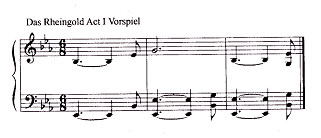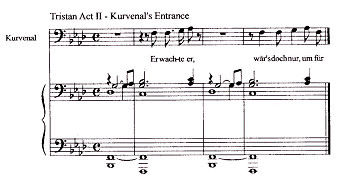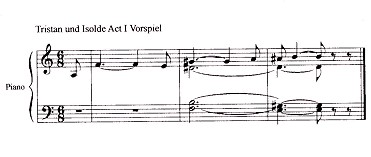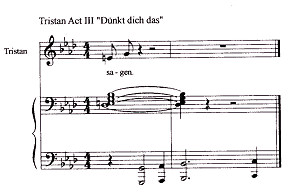Dreams: Richard Wagner's
Five Poems by Mathilde von Wesendonk
an Analysis by Robert Cart
Professional and amateur musicians, musicologists and arm-chair music historians agree that Richard Wagner's (1813 -1883) musical innovations revolutionized opera. His use of leitmotivs, super-human heroes, and the unrivaled scale of his newly conceived genre, the music drama, distinguished him from his contemporaries. Though he focused primarily on composing his thirteen music dramas, he also composed several lieder.
The Fünf Gedichte von Mathilde Wesendonk represent Wager's most extraordinary foray into lieder. The texts are poems by Wagner's paramour, Mathilde Wesendonk, and serve as compositional studies for his greatest music drama, Tristan und Isolde. While the first reference in Wagner's musical works to Mathilde may be the role of Sieglinde in Die Walküre, it is believed that their abstinence from a physical relationship may have fueled the erotic passion of Tristan und Isolde.
In the early 1850's, Mathilde attended a performance of Wagner conducting the overture to Tannhäuser, and from that point on she was infatuated with him. Her interest led to a friendly relationship resulting in frequent visits to the Wesendonk estate by Richard and his wife, Minna. Observing the infatuation, but maintaining decorum, Minna was reportedly coldly cordial to Mathilde. Minna observed the increasing frequency of Richard's unaccompanied visits to Mathilde, and on April 17, 1858, she intercepted a manuscript Richard was sending to Mathilde via a servant; the manuscript was the prelude to Tristan, with the dedication: "to Mathilde Wesendonk". In a final act of triumph, Minna kept the manuscript and arranged for a copy to be delivered to Mathilde after Richard's death.
Broadly speaking, restrained eroticism alternating with sublime, dream-like moments characterizes the Wesendonk Lieder. The following analysis explores each song's specific bond between words and music, placing each of them in a musical context of Wagner's music dramas.
In the opening song, Der Engel (The Angel)
(November 30, 1857), arpeggiated chords evoke the dream-like reminiscence
of childhood stories of angels. The ensuing atmosphere, which dominates
the initial thirteen measures, reminds us of the prelude to Das
Rheingold ("ruhig" and "bewegung" and arpeggiated chords integral
to the spirit of each piece) (fig. 1.1). Abruptly, the peaceful temperament is
interrupted by anxious repeated chords at the languishing of the heart
in sorrow, silently bleeding as it implores for redemption. Bolstered
once again by the Rheingold allusion, the vocal line soars
as if gently lifting the sorrow-laden heart heavenward. Carried "far
from all sorrows," the vocal line is positioned well outside the predominant
E major harmony, creating a dissonant "ferne" ("distant") before a
resolution in G major which carries the spirit heavenward.
Figure 1.1

The striving and passionate musical language of Stehe still! (Stand Still) (February 22, 1858) reminds us of the Tristan und Isolde representation of love's demise just prior to Kurvenal's Act II entrance; the varying diminished chords coalescing with a relentless driving rhythm intensify Wesendonk's anxious pleas to stop the procreating power and restrain the beating of the swelling pulses. Lost in sweet forgetfulness the atmosphere calms, though still driven by repeated chords. Evoked by gentle arpeggios, peace returns as "the being finds itself again in the being" by fusing with the beloved. The lips have fallen mute and the soul is beyond desire in a final recitative phrase that is nearly mute - a cappella. The "riddle of nature" having been solved, the song concludes in C major, anticipating Waltraute's declaration of Wotan's reminiscence of Brünhilde from Göttedämmerung.
Im Treibhaus (In the Hothouse) (May 1, 1858) is a study for Tristan und Isolde. The opening measures represent intertwining branches with the enormous weight of heat; these measures also form the basis of the vorspiel to act III of Tristan, and later introduce Kurvenal's entrance in the same act of that opera (figs. 3.1 and 3.2). The "children from far-off lands" find their home above an e flat minor chord, a harmony somewhat outside the predominant g minor tonality. Abruptly, two juxtaposed tri-tones underlie the open arms "wide in yearning and desire," and clearly anticipate the legendary Tristan chord (a concurrent fourth and tri-tone) which epitomizes the act I vorspiel of that work. (fig. 3.3) The voice quivers fearful of the "fate that we share," but regains strength as it bathes in "light and radiance." As "the sun retires from the empty light of day," the weighty bass melody intimates the night and day imagery of Tristan's bewildered act III "Dünkt dich das." (fig. 3.4) The marcato "heavy drops hanging on the edges of the green leaves" fleetingly violate a benign legato line, which recovers and brings the piece to a hushed end.
Figure 3.1

Figure 3.2

Figure 3.3

Figure 3.4

Identical in pitch to the Act II vorspiel of Tristan und Isolde, the stark initial harmony of Schmerzen (Anguish) (December 17, 1857), concurrently loud and dissonant with its broad pitch range, epitomizes the sadness of an immense sun, crying as it sets at evening. The abrasive chord matures into a melancholy primary motive, followed by a plaintive vocal restatement. Lulled momentarily into the languorous motive, the listener's environment is abruptly cut short as a series of repeated chords announce a death which arrives early. As the sun rises on "the glory of the gloomy world," the musical language transforms into one of anticipation through harmonies evolving from G minor of an early death to A flat major at the rising of the sun in its former magnificence. "A noble, victorious hero" resounds in the piano as a quote of the sword leitmotiv from Das Ring des Nibelungen. (fig. 4.1) As the rationale for grief is mused, the notion of rebirth expounded, and the day and night imagery of Tristan again recounted, the primary motive is treated to a series of transformations, ultimately ending in C major. Once again, the heroic, all-conquering sword theme is heard, this time championing the proclamation: "Oh, how thankful I am that nature has granted me such grief!" There are three variants to the ending of this song. The original G major three-bar ending being deemed unsuitable, Wagner re-composed a six-bar ending. In due course, he completed the final version which is more intimately bound to the primary motive.
Figure 4.1

The dream persists as a vital theme throughout Wagner's works. Tristan, Wotan, Erda, Erik, Kundry and Sieglinde, to name a few heroes, experience dreaming as a fundamental process in the shaping of their fate. Träume (Dreams) (December 4-5, 1857), the closing piece in the cycle, conjures once more the ambiance of day and night imagery so common in Tristan und Isolde. In its very pitches, the opening reverie - provocative and restrained through its masterful use of diminished and seventh chords - portends the act II "O sink' hernieder" from Tristan. (fig. 5.1) The bell-like treble interjections which predominate the opening of the Tristan duet (fig. 5.2) realize their inspiration throughout the prelude and postlude of this work. Consenting only briefly to an a cappella voicing of "desolate nothingness" before returning to an impassioned continuation of the repeated chords, the musical language ultimately evolves into an anxious, dotted rhythm and syncopated bass embodying the blooming of dreams; concurrently, the soaring voice signifies the heavenly message passing blissfully through the soul. As dreams "softly fade away on your bosom, and then sink into their grave," the origins of Tristan's act II "Niewiedererwachens wahnlos hold bewußter Wunsch" become apparent (fig. 5.3). Finally, this study for Tristan und Isolde, and in fact the entire cycle, finds a peaceful conclusion in the reiteration of the Träume prelude.
Figure 5.1

Figure 5.2

Figure 5.3

Notes and Translations by Dr. Jon Robert Cart, Associate
Dean, College of Fine and Performing Arts, Rowan University.
Bibliography and
Robert Cart Biography
Back to Top
Back to Articles
Printer-friendly
format
Home
Calendar
Announcements
Issues
Reviews
Articles
Contact
Us
|

